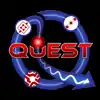
QuEST Program Logo
Quantum Entanglement Science and Technology (QuEST) is a research program, announced by the DARPA Microsystems Technology Office (MTO) in 2008.[1][2] As a follow-on to the QuIST Program, its goal was to further accelerate development in the field of quantum information science.
Example areas under investigation included:[3][4][5][6]
- Shor's factoring algorithm,
- Quantum machine learning,
- Quantum game theory,
- Secure quantum communications,
- Quantum ghost imaging and interaction-free measurement, quantum image processing,
- Remote sensing, quantum radar and quantum metrology, e.g. entanglement-assisted gravitomagnetic interferometry.
See also
- IARPA – Intelligence Advanced Research Projects Agency
References
- ↑ "Pentagon in QuEST for quantum-teleport spooky IT". The Register.
- ↑ "DARPA wants a quantum entanglement revolution". 28 March 2008.
- ↑ "Quantum Entanglement Science and Technology (QuEST) - Federal Business Opportunities: Opportunities". www.fbo.gov. Retrieved 2018-01-12.
- ↑ DARPA (March 26, 2008). "QuEST Broad Agency Announcement (PDF)".
- ↑ "Quantum Entanglement Science and Technology (QuEST) - Microsystems Technology Office". 2009-10-14. Archived from the original on 2009-10-14. Retrieved 2018-01-12.
{{cite web}}: CS1 maint: bot: original URL status unknown (link) - ↑ "Microsystems Technology Office". www.darpa.mil. Retrieved 2018-01-12.
External links
- QuEST Program overview (archived web page)
This article is issued from Wikipedia. The text is licensed under Creative Commons - Attribution - Sharealike. Additional terms may apply for the media files.